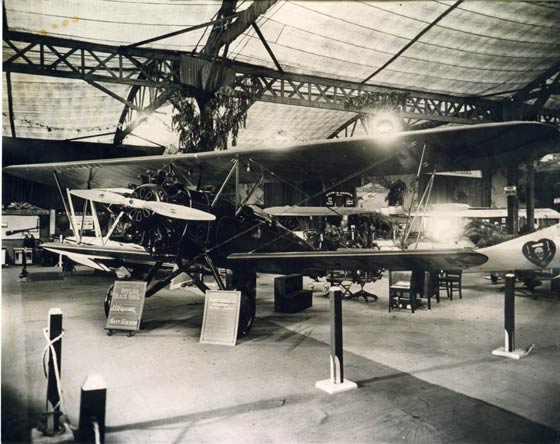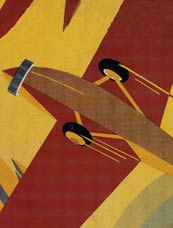|
This airplane is a Butler Blackhawk. It was the sixth airplane manufactured by the Butler Aircraft Company, Kansas City, MO, with serial number 105. Since the first one rolled off the factory floor in October, 1928, NC730K was probably built sometime during 1929-30 under Type Certificate #135. It had a Wright J-5 engine of 220 HP equipped with a hand-cranked, inertial starter. It was a 3-place airplane.
Register pilot and Dole Race winner Art Goebel (see left sidebar) flew one of the early production models in a test from Kansas City to San Antonio, TX. Upon his return he liked the airplane so much that he purchased it for his personal craft. His airplane was NC521 (serial number 103; not a Register airplane).
The Blackhawk was a rare airplane, with probably less than twenty ever made. Juptner (cited, left sidebar) cites only 12 individual registrations in his book (Volume 2, page 104). The reason? The Crash of 1929 practically nullified the sales potential for the airplane.
Below, an image of NC730K on exhibit at what is probably an exhibition hall near Mines Field.
Butler Blackhawk NC730K, Pan Pacific Auditorium, Ca. 1933 (?) (Source: Granger)
 |
Below, the caption for this photograph written by Norm Granger (date of caption unknown). It clearly states the date and location. However, it is not the Pan Pacific Auditorium. Please see this photograph taken at a known location during the 1928 National Air Races. Note the similarities of exhibition style, the superstructure and fabric ceiling.
Caption for the Photograph of NC730K (Source: Granger)
 |
---o0o---
A digression: Looking around this image is instructive. Besides the "No Smoking" sign and potted plants, the two signs in front of the Blackhawk are difficult to read, even on the original. The left-hand one says "Butler Black Hawk" "J.E. Granger" and "Hoot Gibson". The right-hand one says "Pacific School of Aviation" on the first two lines; the rest is unreadable, but it looks like there is a group of signatures continuing down the sign.
Quite readable is the registration number of an aircraft directly behind the Black Hawk. It reads "NX65M". It is not a Register airplane, and I find no reference to it on the Web. Likewise, there is another registration number just over the heart, skull and crossbones of the Hanriot (see below) at far right. The registration is "NC***L". The other numbers are obscured by the roof pillars. There is no Register airplane with a trailing "L".
Over the wing of NX65M is an exhibit along the wall that scrolls "Otto K. Olesen" across the top. Barely readable is "Lighting and Equipment". Otto Olesen was the inventor of the Klieg light system, and was the Hollywood Bowl's technical director for many years. In the early 1930s he owned Otto K. Olesen Illuminating Co., Ltd. of Hollywood. During the Great Depression he advertised in magazines like Popular Mechanics, pushing his "amazing business secret from Hollywood", which amounted to acquiring and reading his free book entitled, "Money Making Secrets in the Electrical Business" and then selling publicity lighting to businesses.
During the 1950s, Olesen became the Postmaster for the City of Los Angeles. He was the defendant named in a law suit by ONE, Inc., publisher of the monthly newsletter of the Mattachine Society. The Society was one of the earliest homophile organizations in the country. These newsletters, were routinely seized by the U.S. Post Office on the grounds of obscenity. That the founders of the Society were affiliated with the Communist party at the time probably did not help the prejudice against them.
The founders of ONE, Inc. sued Olesen in his role as the Postmaster of the City of Los Angeles. The court ruled initially with the Postal Service, as did the 9th Circuit Court of Appeals. In 1958, however, an appeal by ONE, Inc. to the Supreme Court was accepted. ONE Inc. v. Olesen marks the first time in US legal history that the Supreme Court explicitly ruled on homosexuality.
At far left in the photograph is a firefighting products display. "FIRE FREEZ" (there doesn't appear to be an "E" at the end) is readable on the sign. There are two high-pressure tanks and an application horn just under the lettering.
At the link is a YouTube video of the façade of the Auditorium taken by a visitor from New Zealand in 1987. Please let me KNOW if this link becomes invalid. End digression.
---o0o---
To continue with the airplane, we find the Black Hawk at Tucson twice, flown by James E. Granger. Each time he carried a single passenger, and they were on cross-country voyages. His first landing was on Friday, September 5, 1930 at 6:30 PM. He had departed Amarillo, TX earlier that day. He and his unidentified passenger remained overnight departing the next day at 8:30 AM westbound to Santa Monica, CA, Clover Field, Granger's home base.
Its second visit was a year later, on Saturday, September 12, 1931 at 10:30 AM. Granger carried his wife and fellow Register pilot, Clema Granger, as his single passenger. They arrived from El Paso, TX and were westbound to Santa Monica.
The Granger's business at Clover Field included distributing Blackhawk aircraft. NC730K was purchased near the beginning of the production run by Hollywood screen cowboy "Hoot" Gibson for his private use. The sign in front of the right wheel in the photo above identifies the airplane as being owned by Gibson. Please direct your browser to Jim Granger's page where there is a photograph of him with Gibson standing in front of an unidentified Blackhawk, which is most probably NC730K.
Also at Granger's page you will find him standing in front of Charles Nungesser's Hanriot, which is visible on the right of the photo above with the skull and crossbones motif on the fuselage.
The Blackhawk was a robust airplane with speed, payload and range enough for extensive and efficient cross-country travels. Further, according to Juptner, "Foremost among the 'Blackhawk's' many features was a rugged construction of exceptional rigidity, which would allow the average pilot to vent his exuberance by man-handling this craft in the air as much as he dared and not have to worry about it's coming apart." It had a cruising speed of 110 MPH.
Another interesting feature of the Blackhawk was that it had both left- and right-hand throttles, so the pilot could fly with either hand. I suppose this could serve as a safety measure, too. If the rigging was done appropriately, in the event one throttle cable broke the redundant one could take over. A metal cover for the front passenger cockpit could increase cruising speed by 5 MPH when installed. Independent wheel brakes were standard, even though the airplane was equipped with a tail skid. I have no further information about the airplane.
---o0o---
THIS PAGE UPLOADED: 01/06/09 REVISED: 01/12/10
|



